Last Updated on February 18, 2025 by Kittredge Cherry
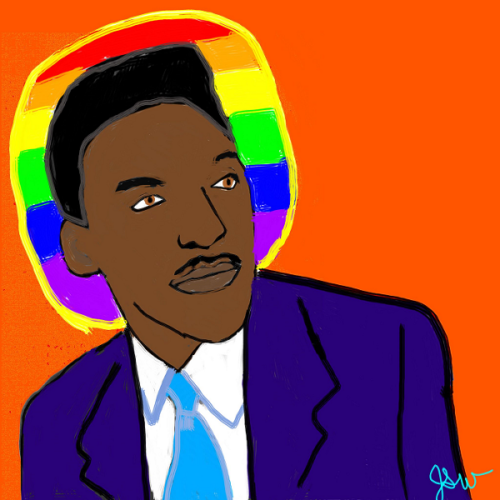
Bayard Rustin was a black gay activist and the genius behind the civil rights movement. He became the chief organizer of the 1963 Civil Rights March on Washington where where Martin Luther King gave his historic “I Have a Dream Speech.” A follower of the Quaker faith with its pacifist tradition, he brought Gandhi-style non-violent protest techniques to the movement for racial justice and become a close advisor to King. Rustin died on Aug. 24, 1987 at age 75.
 Pushed into the background because he was openly gay, Rustin has been called “an invisible hero,” “a lost prophet” and “Brother Outsider.” Some see him as an LGBTQ saint. He summed up his philosophy when he said, “We need, in every community, a group of angelic troublemakers.” He is credited with coining the popular phrase “speak truth to power.” It means telling the truth to authorities who may be offended — a non-violent tactic that Rustin used effectively.
Pushed into the background because he was openly gay, Rustin has been called “an invisible hero,” “a lost prophet” and “Brother Outsider.” Some see him as an LGBTQ saint. He summed up his philosophy when he said, “We need, in every community, a group of angelic troublemakers.” He is credited with coining the popular phrase “speak truth to power.” It means telling the truth to authorities who may be offended — a non-violent tactic that Rustin used effectively.
Some honor him as a gay saint. Rustin has a rainbow halo in an icon by queer North Carolina artist Jeremy Whitner. It appears at the top of this post. Votive altar candles with Rustin’s face are included in the Luminaries Collection at the Flaming Idols Etsy shop.
The Presidential Medal of Freedom, the nation’s highest civilian honor, was awarded to Rustin in a White House ceremony in 2013. “For decades, this great leader, often at Dr. King’s side, was denied his rightful place in history because he was openly gay. No medal can change that, but today, we honor Bayard Rustin’s memory by taking our place in his march towards true equality, no matter who we are or who we love,” President Obama said when he presented the medal for Rustin.
 A historical novel explores the friendship between Rustin and King — including whether King would consider the LGBTQ movement a civil rights issue. The answer is a resounding yes in “Bayard and Martin: A Historical Novel About Friendship and the Civil Rights Movement” by Frederick Williams, Texas legislator Lane Denton, and AIDS activist Sterling Zinsmeyer. Williams is a prolific author who helped establish the African American studies department at the University of Texas at San Antonio. It was published by Jaed Publications in 2019.
A historical novel explores the friendship between Rustin and King — including whether King would consider the LGBTQ movement a civil rights issue. The answer is a resounding yes in “Bayard and Martin: A Historical Novel About Friendship and the Civil Rights Movement” by Frederick Williams, Texas legislator Lane Denton, and AIDS activist Sterling Zinsmeyer. Williams is a prolific author who helped establish the African American studies department at the University of Texas at San Antonio. It was published by Jaed Publications in 2019.
Rustin was an openly gay trailblazer
Bayard Taylor Rustin (Mar. 17, 1912 – Aug. 24, 1987) was born in West Chester, Pennsylvania on Mar. 17, 1912. His parents were Florence Rustin and Archie Hopkins, but he was raised by his maternal grandparents. His grandmother, Julia Davis, was Quaker, but attended the African Methodist Episcopal Church with her husband, Janifer Rustin. He attended Wilberforce College, a historically black college run by the AME Church in Ohio, and Cheyney University of Pennsylvania.
The Quakers, also known as the Religious Society of Friends, are a group with Christian roots that began in England in the 1650s. They emphasize the guidance of the Holy Spirit, have silent worship that rejects outward rites and ordained clergy, and have a long tradition of working for peace.
Rustin credited his Quaker background for turning him into an advocate for others. “My activism did not spring from being black. Rather it is rooted fundamentally in my Quaker upbringing and the values instilled in me by the grandparents who raised me,” he said. His early speeches were steeped in Biblical references, but later he tended to speak more universally.
Rustin joined the Religious Society of Friends (Quakers) in 1936. The following year he moved to New York City, where he became part of the black culture scene in Harlem. He joined the Manhattan Quaker church known as the Fifteenth Street Friends Meeting and the Young Communist League. His spirituality is summed up in his popular quote: “God does not require us to achieve any of the good tasks that humanity must pursue. What God requires of us is that we not stop trying.” A 2022 video interview with Naegle from QuakerSpeak examines how Quaker values shaped his life.
Rustin rarely served as a public spokesperson for civil rights because he was openly gay at a time when homosexuality was criminalized and stigmatized. His sexuality was criticized by both segregationists and some fellow workers in the peace and civil-rights movements. In the 1970s he began to advocate publicly for lesbian and gay causes.
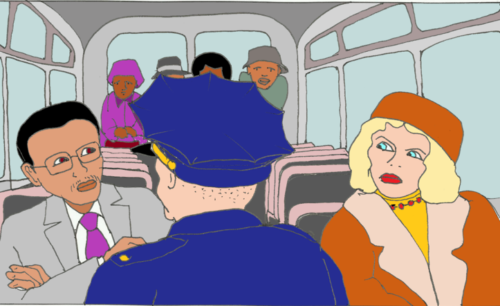
Rustin was arrested in 1942 for defying segregation laws by sitting in the front of a bus. The scene is rarely depicted by artists, but it is part of the f2023 book “Heavenly LGBTQ+: Queer Icons from LGBTQ Life, Religion, and History” by Jan Haen, a Dutch artist and Roman Catholic priest. It is the sequel to his 2022 book “Heavenly Homos, Etc..”
Rustin and queer saint Pauli Murray both helped found the Congress of Racial Equality in 1942. In the 1940s both Rustin and Murray were associated with the influential Harlem Ashram, a community exploring how to use Gandhi’s nonviolent methods to end racial discrimination. Rustin lived nearby and was a frequent visitor, and Murray lived briefly at the ashram.
These two queer civil-rights icons became friends, but Murray was critical of how he supported male dominance in civil-rights groups. For example, Murray and others appealed to Bayard for a woman to speak at the 1963 March on Washington, but he refused. I’m going to add this info to my profiles of them at Q Spirit.
His decades of achievements include helping launch the first Freedom Rides in 1947, when civil disobedience was used to fight racial segregation on buses. He was active in the Fellowship of Reconciliation, the oldest and largest peace and justice organization in the United States. In 1948 he traveled to India to learn non-violent resistance directly from leaders of Gandhi’s movement. He helped organize the Southern Christian Leadership Conference and much more. From 1955-68 Rustin was a leading strategist for the African American civil rights movement.
Rustin’s sexual orientation became publicly known in 1953, when he was arrested for homosexual activity in Pasadena, California. It was not his first stint in jail. He had been arrested before for his pacifist refusal to participate in World War II and he served on a chain gang for breaking Jim Crow laws requiring racial segregation on public transportation.
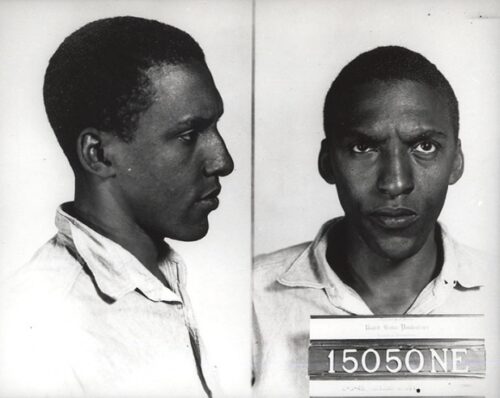
Mug shot of Bayard Rustin (Wikimedia Commons) taken for failure to report for his Selective Service physical exam
In the last part of his life, Rustin was criticized by some of his former allies because he rejected identity politics and criticized the “black power” movement for isolating black people and empowering racists.
Walter Naegle was Rustin’s life partner from 1977 until his death a decade later. As executor and archivist for the Bayard Rustin estate, Naegle continues to promote Rustin’s legacy by organizing programs and providing materials for books and exhibits on Rustin’s amazing life.
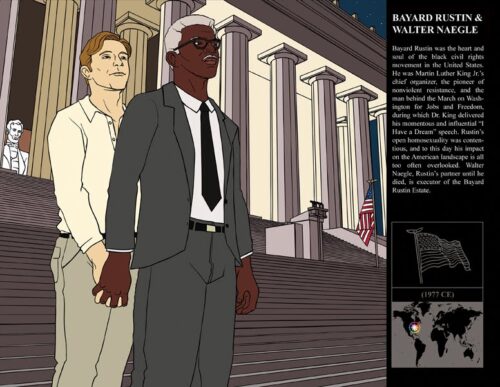
“Bayard Rustin and Walter Naegle” by Ryan Grant Long
In 2020 the California governor pardoned Rustin, who was arrested on Jan. 21, 1953, for having consensual gay sex. He was jailed for 50 days and forced to register as a sex offender. He was arrested in Pasadena, California, where he was discovered having sex with two men in a parked car. It happened just hours after he gave a speech on anti-colonial struggles in West Africa. On the 67th anniversary of his arrest, leaders of the LGBTQ and Black caucuses of the California legislature asked Governor Gavin Newsom to posthumously pardon him. On Feb. 4, 2020, he issued the pardon in an effort to correct the “long and reprehensible history of criminal prohibitions on the very existence of LGBTQ people and their intimate associations and relationships.” The governor also issued an executive order creating a process for pardoning others who were “subjected to discriminatory and unjust arrest and prosecution for engaging in consensual adult sexual conduct.”
Bayard Rustin loved art and music
“The link to Bayard’s spirituality and his esthetic sensibility (both art and music) is important, and not often emphasized,” Naegle told Q Spirit.
A little-known fact is that Rustin was a passionate art collector of 15th-, 16th- and 17th-century religious art and icons. After his death, his estate donated three icons donated to Metropolitan Community Church of San Francisco. His collection is documented in the 1998 New York Times article “The Private Icons of a Civil Rights Legend” and the 1989 exhibition catalog “Bayard Rustin as Art Collector: A Study of Selections of African, Asian and European Art in the Collection of a Prominent African American.” It was published by Kean College of New Jersey. His collection included a large Ming-Dynasty bronze sculpture of Kuan Yin, the androgynous spirit of compassion.
His artistic pursuits were musical too. An article on his interest in early music is scheduled to appear in the fall issue of Early Music America. Rustin was also a talented tenor singer.
A CD titled “Bayard Rustin: The Singer: Negro Spirituals, Lute Songs and More” was released in May 2022 by Parnassus Records with him singing Elizabethan songs and African American spirituals. The recordings come from hard-to-find LPs made in the early 1950s for the Fellowship of Reconciliation. Some are also available on YouTube, such as “Nobody Knows the Trouble I’ve Seen.”
Rustin connected LGBTQ, racial and gender equality
 Rustin saw the connections between racial justice, women’s equality and LGBTQ rights. He made it vividly clear in a controversial speech to the Philadelphia chapter of Black and White Men Together on March 1, 1986. The speech, titled “The New ‘N*s’ are Gays,” is one of several pieces about LGBTQ rights in his book Time on Two Crosses: The Collected Writings of Bayard Rustin
Rustin saw the connections between racial justice, women’s equality and LGBTQ rights. He made it vividly clear in a controversial speech to the Philadelphia chapter of Black and White Men Together on March 1, 1986. The speech, titled “The New ‘N*s’ are Gays,” is one of several pieces about LGBTQ rights in his book Time on Two Crosses: The Collected Writings of Bayard Rustin. Rustin states:
“Today, blacks are no longer the litmus paper or the barometer of social change. Blacks are in every segment of society and there are laws that help to protect them from racial discrimination. The new “n*s” are gays. … It is in this sense that gay people are the new barometer for social change. … The question of social change should be framed with the most vulnerable group in mind: gay people.”
The following year Rustin died of a ruptured pancreas on Aug. 24, 1987. Late August is also significant for him because the March on Washington held on Aug. 28, 1963. Organized by Rustin, the March was where King gave his famous “I Have a Dream” speech. An estimated 250,000 people attended, making it the largest demonstration held in the U.S. capital until that time. The full synthesis of Rustin’s black and gay identities — the “two crosses” of his book title — came as the culmination of a life well lived.
Bayard Rustin honored in art, books and film
Openly gay actor Colman Domingo received an Academy Award nomination as best actor for starring in “Rustin.” The 2023 retelling of the activist’s life is produced by former US President Barack and Michelle Obama’s production company Higher Ground Productions. It is available on Netflix.
Rustin has a floral halo in an icon from the Queer Saints Project by Jason Tseng, a Chinese American non-binary illustrator based in New York City. “Bayard Rustin was a lifelong Quaker, so to honor his spiritual journey I selected a flower known as ‘Quaker Ladies’ to populate his halo,” Tseng said. The background of pink, lavender and blue hints at the ways that Rustin blended and defied traditional masculinity and femininity.
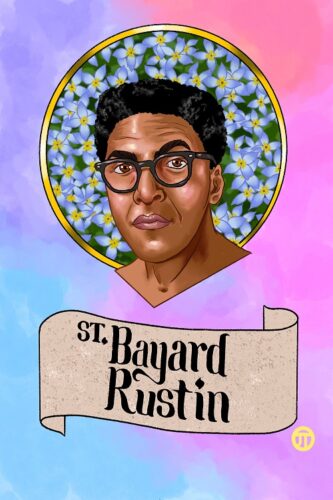
“Saint Bayard Rustin” by Jason Tseng
The Queer Saints Project honors queer ancestors as modern-day saints of the LGBTQ movement. The series began when Judson Memorial Church commissioned Tseng to create icons of LGBTQ figures to carry in the Queer Liberation March. Tseng honors their contributions and celebrate their inherent divinity by combining images of nature, Christian sacred iconography, and historical photography.
Rustin has a halo with the rainbow colors of the LGBTQ community in a 2022 portrait by North Carolina artist Jeremy Whitner. It appears at the top of this post. Whitner told Q Spirit that the red background symbolizes life and Rustin’s passion for it. Whitner is a queer Christian iconographer in process for ministry with the Disciples of Christ. He attends Union Presbyterian Seminary in Charlotte, North Carolina. His icons appear frequently on Q Spirit and are available at Whitner’s Fine Art America shop.
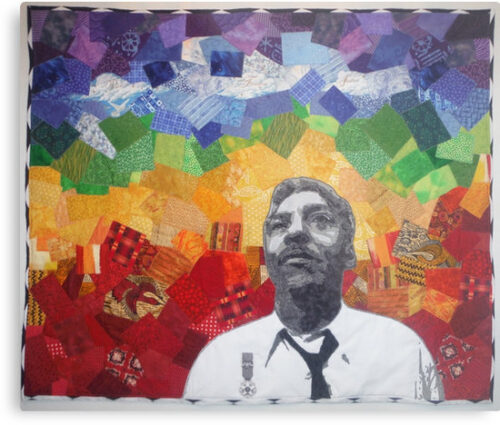
Detail from “Bayard Rustin” art quilt by Sabrina Zarco
Rustin appears against a quilted background reminiscent of a rainbow flag in a tapestry portrait by queer Chicana autistic artist Sabrina Zarco. Yellow light around his head suggests a halo. “The implied rainbow and words in the clouds in this work speak to the many causes for which he worked and his love of all things hand made by marginalized artists,” Zarco said in her artist’s statement. “His necktie with musical notes is a nod to his love of music and time as a musician. He wears the 2013 Presidential Medal of Freedom on his chest.” The original artwork was unveiled at a National Black Justice Coalition event after Naegle accepted Bayard’s medal. It is now in the private collection of black LGBT activist Mandy Carter, cofounder of the coalition. The image is available for purchase at the artist’s online store.
Rustin appears with a pink circle — perhaps a pink halo — in a portrait from the “LGBTQ+ Icons” series by Andrew Ahern, an artist based in Manchester, England.

“Bayard Rustin” by Andrew Ahern. Prints are available at the Andrew Ahern Art Etsy shop.
Rustin’s biography is told in the film Brother Outsider: The Life of Bayard Rustin and books such as Lost Prophet: The Life and Times of Bayard Rustin
by historian John D’Emilio. The book “I Must Resist: Bayard Rustin’s Life in Letters“, edited by Michael Long, was a 2013 finalist for a Lambda Literary Award. A chapter on Bayard Rustin by Patricia Nell Warren is included in the 2015 book “The Right Side of History: 100 Years of LGBTQI Activism.” Rustin is even featured in an LGBTQ history book for teens: “Queer, There, and Everywhere: 23 People Who Changed the World” by Sarah Prager, published in 2017. The opening chapter of the 2019 book “Not Straight, Not White: Black Gay Men from the March on Washington to the AIDS Crisis” by Kevin Mumford focuses on Rustin, along with James Baldwin and Lorraine Hansberry. The book “Bayard Rustin: A Legacy of Protest and Politics” by Michael G. Long (editor) was published by New York University Press in 2023.
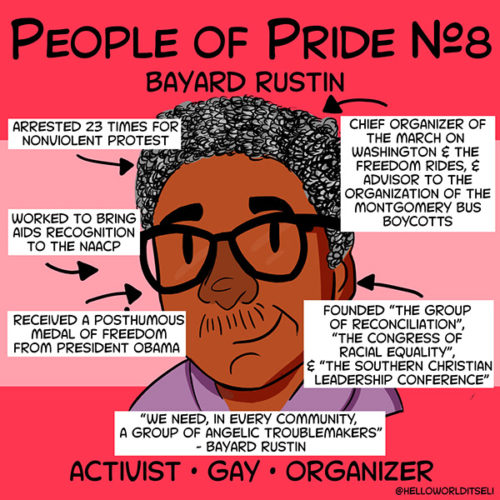
“Bayard Rustin: People of Pride No. 8” by Elijah Haswell
Rustin is also included in the “People of Pride” project by Elijah Haswell, a queer transgender artist dedicated to accessible, inclusive non-fiction. The series celebrates historic LGBTQ+ Americans with cartoon-like portraits, boxes packed with fun factoids, and a quick quotation. Haswell began the series in 2018 and it was so popular that a “People of Pride” book was released in 2019 with redrawn illustrations.
In the another image, Rustin and Naegle hold hands as an interracial gay couple on the steps of the Lincoln Memorial. It was created by artist Ryan Grant Long for his “Fairy Tales” series of gay historical figures. For more on Long, see my previous post Artist paints history’s gay couples: Interview with Ryan Grant Long.
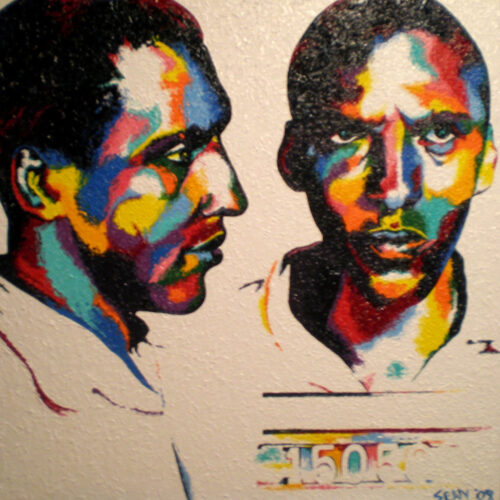
“Bayard Rustin – Pride” by Sean J. Randall
A different kind of rainbow portrait created by Portland artist Sean J. Randall. He adds rainbow colors to Rustin’s mug shot to emphasize his gay pride.
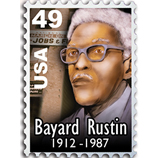 A campaign was launched to convince the U.S. Postal Service to honor Rustin with a postage stamp.
A campaign was launched to convince the U.S. Postal Service to honor Rustin with a postage stamp.
The play “Blueprints to Freedom: An Ode to Bayard Rustin,” starring and written by Michael Benjamin Washington, premiered in fall 2015. It was a co-production of the Kansas City Repertory Theatre and La Jolla Playhouse in California. Set in summer 1963, it shows how his gay orientation was considered a public relations problem when Rustin is planning the march. Other characters include King and Rustin’s ex-lover Davis Platt. Washington discusses Rustin as a lost prophet and American hero in a YouTube video preview of the play.
“The best for me lies elsewhere”
The difficulty that Rustin overcame in order to embrace his sexual orientation is expressed in a letter he wrote in the 1940s:
“I must pray, trust, experience, dream, hope and all else possible until I know clearly in my own mind and spirit that I have failed to become heterosexual, if I must fail, not because of a faint heart, or for lack of confidence in my true self, or for pride, or for emotional instability, or for moral lethargy, or any other character fault, but rather, because I come to see after the most complete searching that the best for me lies elsewhere.”
Bayard Rustin prayer
Q Spirit’s Litany of Queer Saints includes this line:
“Like Saint Bayard Rustin, may we stand up and speak out for our LGBTQ dreams…”
Links related to Bayard Rustin
Bayard Rustin Oral History (LGBTQ Religious Archives)
Walter Naegle, Activist Bayard Rustin’s Partner, On Rustin’s Enduring Legacy (Lambda Literary)
The story of Bayard Rustin, openly gay civil rights leader (PBS Newshour)
___
Top image credit:
Bayard Rustin icon by Jeremy Whitner
___
This post is part of the LGBTQ Saints series by Kittredge Cherry. Traditional and alternative saints, people in the Bible, LGBTQ martyrs, authors, theologians, religious leaders, artists, deities and other figures of special interest to lesbian, gay, bisexual and transgender and queer (LGBTQ) people and our allies are covered.
Editor’s note: This article was originally published in August 2017, was expanded with new material over time, and was most recently updated on Jan. 19, 2025.
Copyright © Kittredge Cherry. All rights reserved.
Qspirit.net presents the Jesus in Love Blog on LGBTQ spirituality.

















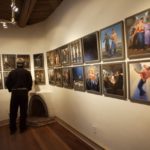


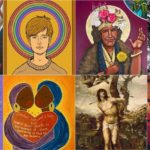
Trackbacks/Pingbacks